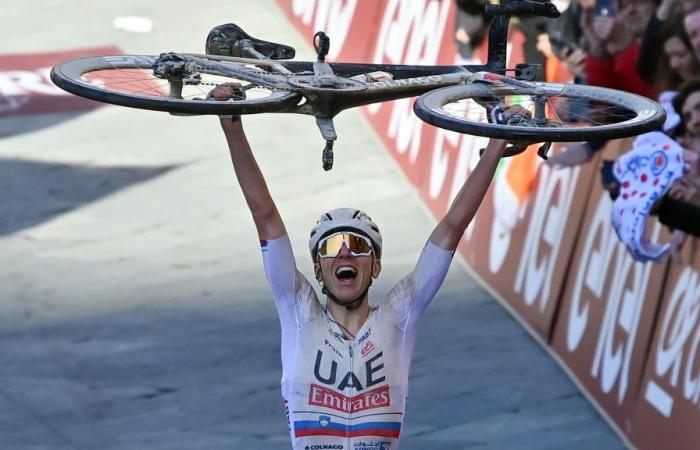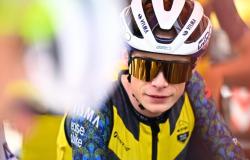Having become machines tuned to the millimeter, bikes are the subject of a technological war between manufacturers and are often highlighted or singled out to justify the successes or failures of certain teams. But what is their real influence on the performances of the riders and should we see an element of fantasy in this?
At this rate, there will soon be no more room on the body. Accustomed to getting tattoos of his team’s greatest successes, Julien Jurdie, sports director of Decathlon-AG2R La Mondiale, had undoubtedly not anticipated such a harvest this year. Since January, his men have already brought home twenty-six bouquets. That is seventeen more than in the whole of 2023. Before attacking the 2024 Tour de France this Saturday in Florence, only the Lidl-Trek and the UAE of the gluttonous Tadej Pogacar display better statistics within the World Tour.
This canon form, the Chambéry training justifies it both by the restructuring carried out internally with the arrival of Decathlon as title sponsor, the dimension taken by its captain Benoît Cosnefroy and the emergence of a generation full of promises carried by Valentin Paret-Peintre, stage winner at the last Giro, and Paul Lapeira, newly crowned French road champion. It’s also hard not to mention the role played by the new Van Rysel bike. Internally, compliments are pouring in about this machine designed, tested and assembled in Lille by Decathlon’s high-end subsidiary, and which the competition is now scrutinizing with attention.
“AG2R did not go from a scrap metal Eddy Merckx to a Ferrari”
Which naturally leads to asking THE question: what is the real influence of the bike on performance? “I reassure you, between a good bike and good legs, nothing will ever replace good legs. If you are not good and you are four kilos too much on the scale, you will not win, even with the best bike in the world”, smiles the former rider and team manager, Jérôme Pineau, who opened a cycle shop in Pornic (Loire-Atlantique) offering bikes from the American brand Specialized.
“The Van Rysel is excellent, but it’s not revolutionary. Last year, AG2R didn’t have trash, they were equipped by the Swiss BMC, which is one of the reliable names in the peloton and yet it didn’t work. It would be too easy to blame everything on the equipment. They didn’t go from an old Ridley or a scrap metal Eddy Merckx to a Ferrari. The difference is that now their supplier takes care of producing their bike from A to Z. They no longer go looking for chains on one side, bearings and sprockets on the other. The tinkering, which had finally tired Romain Bardet, is over,” says Pineau.
However, it has been a long time since racing was only played out on the hours of effort swallowed up in training and the physical capacities of the riders, but also on technology. Popularized by Dave Brailsford’s Sky in the early 2010s, the famous quest for “marginal gains”, namely the addition of small improvements at different levels supposed to improve performance, has spread to the entire peloton. And in all areas.
Working in the wind tunnel to correct runners’ positions has become the norm, as has developing ever more aerodynamic jerseys and integrating multi-qualified nutritionists into the staff. The bicycle does not escape this science of detail. Frame, tires, gears, crankset, derailleur: everything is designed to gain speed and aerodynamics. When extending or joining another creamery, the question of equipment is often made a priority by a leader in the negotiations, and among manufacturers nothing is left to chance to respond to this dazzling development.
Real pressure for manufacturers
Van Rysel engineers thus designed their baby by collaborating with a company specializing in aerospace (Swiss Side) and with Onera, the National Office for Aerospace Studies and Research, known in particular for its work… on the Rafale combat aircraft.
“They also build rockets and we asked them to build a bicycle. They found the challenge extremely interesting,” Nicolas Pierron, creator and boss of Van Rysel, explained to us in May.
As a result, the car developed in the North, which is the subject of regular exchanges between riders and mechanics, is described in the peloton as “ultra fast” and “properly nervous”. “Of course it is the athlete who wins the races and not the bike, you have to have that in mind. But in our sport, the approach is extremely scientific at all levels, from training to reflection around the equipment. We cannot afford to offer a bike that is not at the cutting edge. We must be able to innovate on the tubulars, the wheels, the chainrings, in short on every little thing that can allow a speed gain. I was a runner, we focused on the weight of the bike and its rigidity Today, we look at everything Because it can make the difference on a climb, a descent, at the end of a sprint, and because the. rider must be convinced that he has the best equipment. Otherwise, it will generate doubt in him about his real ability to be able to fight on equal terms with his opponents”, explains Cyril Dessel, stage winner on the 2008 Tour. current sports director at Decathlon-AG2R La Mondiale.
It is probably this confidence in his bike, and not just the zeros aligned on the contract, that recently convinced Mathieu Van der Poel to re-sign until 2034 (!) with the Germans of Canyon. A relationship of loyalty reminiscent of that between Peter Sagan and Specialized, the Slovakian having taken on the role of ambassador for life of the American firm.
As for Tadej Pogacar, we saw him last March proudly lifting his Colnago V4RS when crossing the line first on the Strade Bianche, as an indirect response – and a marketing coup – to the criticism leveled against his Italian supplier. “If Pogacar rides a Visma, Ineos or Soudal-Quick Step bike tomorrow, the others will have no chance. With one of their bikes, a Cervélo, a Pinarello or a Specialized, he could pedal 2km/h faster” , launched in 2023 the Belgian Dirk De Wolf, winner of Liège-Bastogne-Liège in 1992, joined in his comments by the legend Tom Boonen.
“Colnago is catching up, but they still have an old-school bike, they haven’t mastered the aero thing yet,” the 2005 world champion had said, before backpedaling.
Proof of the sensitivity of the subject, and the dimension taken by this technological war between manufacturers, Colnago had responded by inviting Boonen to come and test its bikes and by highlighting the “millions of euros” spent on research and development since the beginning of its partnership with UAE Emirates. But then what are the key elements of an excellent bike? Which component has the most influence? Perhaps the frame whose aerodynamics can prove decisive on the flat and more particularly in time trials? The tire since it is in direct contact with the ground? Or the seat post which must be able to withstand the physical position of the rider?
“The wheels are a crucial point, and more generally everything that immediately comes into contact with the air, such as the fork, the handlebars, the head tube… You also have to find the right balance with the rear triangle and the bottom bracket. But you shouldn’t think that a rider is successful simply because he has a great bike. And vice versa if he has bad results,” qualifies Frédéric Grappe, performance director at Groupama-FDJ.
“Hardware does a lot but it doesn’t do everything”
“There is a lot of talk about aerodynamics in the evolution of equipment. Except that we often forget that the rider has a considerable influence depending on his position on his bike. Let’s take a rider who runs at 50km/h with his arms outstretched on his handlebars, and this same rider who runs at 50km/h with the good reflex of having his elbows bent and his hands on the hoods. We will have between 70 and 80 watts of difference, which is enormous. The rider represents 70% of the air resistance (or aerodynamic drag), the bike takes the remaining 30%”, he continues.
Before imagining another situation: “Let’s take a climb of a pass that lasts half an hour. The aerodynamics will weigh very little. On the other hand, if with each pedal stroke your bike does not respond well in return when you deform it, it is a lot of energy badly spent. It can be five watts that escape on each pedal stroke if the bike is too stiff, too hard, and the elastic return is not good. So, yes, the bike is important, like the morphotype of the rider, his position and the race conditions. But to say that we obtained such and such a result above all thanks to our bike is false.”
Jérôme Pineau goes even further and is categorical: “A good bike doesn’t win races. It can make you lose more than you win. I’ve often had this debate with my riders at B&B Hotels. We did our best Tour de France on a KTM. High performance is achieved on machines that are set to the millimeter, some brands are above the others and allow you to attract stars, but an average rider on a great bike won’t become a great rider. Equipment does a lot but it doesn’t do everything. Give any bike or almost any bike to the excellent rider that is Paul Lapeira, with his passion and talent he will still win.” Are you sceptical about the Tour de France?




